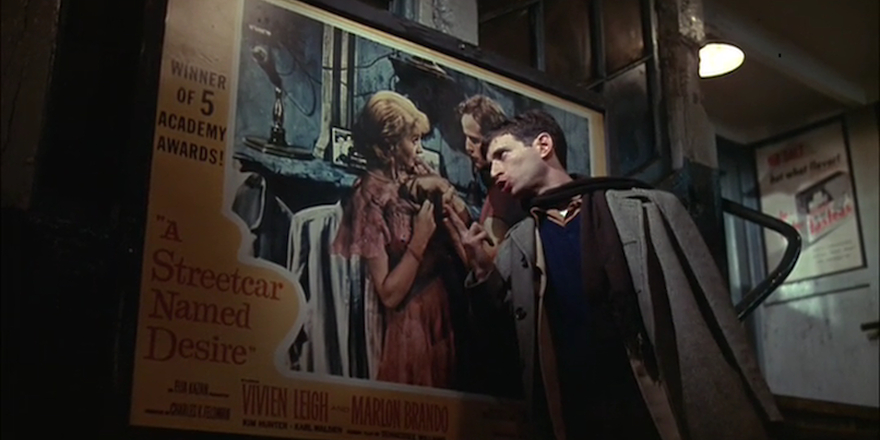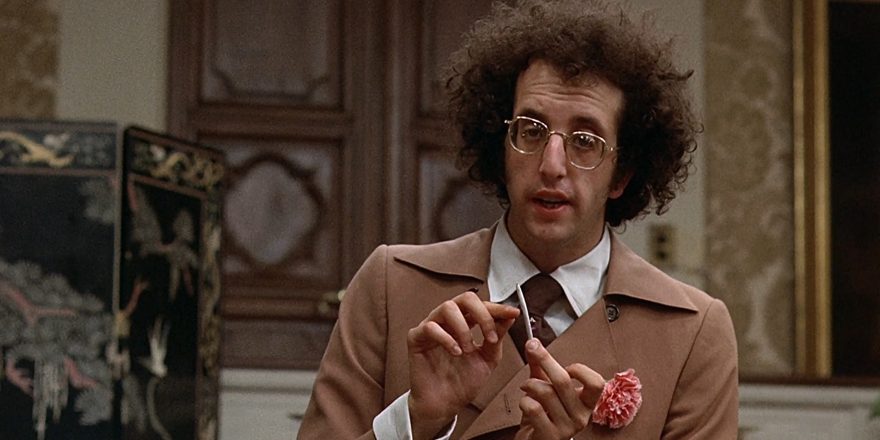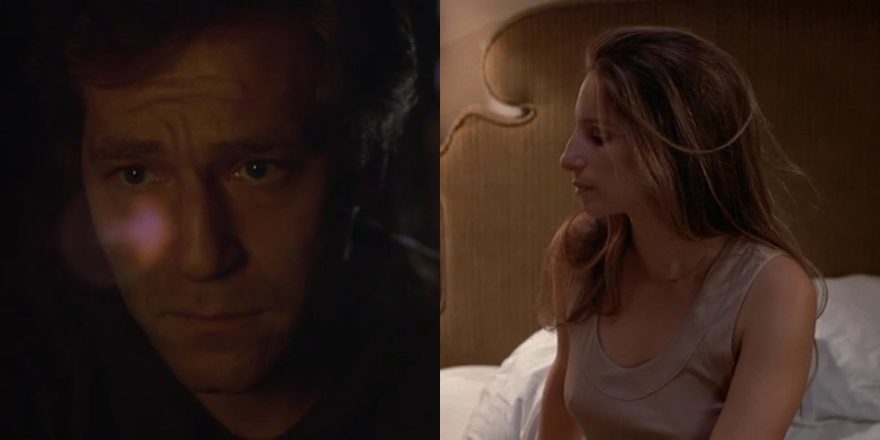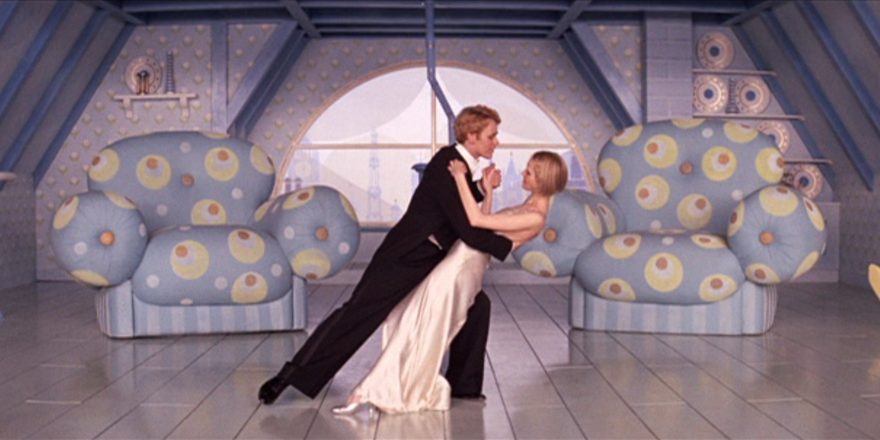There’s a beautifully observed scene at the start of writer-director Paul Mazursky’s extraordinary 1976 film Next Stop, Greenwich Village, a semi-fictionalized memoir set in 1953, in which a young Jewish man in his early twenties, Larry Lapinsky (based on Mazursky, played by Lenny Baker), is packing up his Brownsville, Brooklyn bedroom into a single suitcase. He takes a framed certificate of acting merit (for his college performance in Thornton Wilder’s The Skin of Our Teeth) off his wall, but decides to hang it back up. He moves over to the open top drawer of his dresser, pulls out a yarmulke, places it on his head (like trying out which hat would look good), then puts it back in the drawer. The camera follows him into the kitchen where his parents, Ben and Faye Lapinsky (played by Mike Kellin and the seismic Shelley Winters) anticipate his goodbyes. “What did you leave?” she asks with increasing hysteria, as his father sits passively reading the newspaper. “Left some pictures, left some books,” Larry responds. “I’ll pick them up when I come back.” There’s no mention of the yarmulke in the top drawer.
Mazursky deftly, without explanation, signals that Larry is leaving his religion behind, but not his Jewish identity. There is no mezuzah nailed to the entrance of Larry’s new Greenwich Village apartment, yet the film revels in the New York Jewish experience, from the turn-of-the century immigrant culture on display in the streets of his Brownsville neighborhood that bookend the film, to the bohemian and intellectual life he moves toward in Greenwich Village. (I relate to this now, just as I related in 1976 – as a non-practicing Jew whose last religious embrace was my Bar Mitzvah – and Jewish humor and sensibility remains deeply embedded in my identity.)
As a South Florida ’70s teenager with creative ambition, I was always drawn to films about leaving. Not in the sense of refuge from war or bad marriages or abusive households, but of moving on: the rite of passage illustrated on screen in brushstrokes of possibilities. As early as I could remember, I plotted my escape, seeking out clues from the outside world and scanning for identification in the films I was seeing weekly. In my formative pre-teen and teenage years, I could relate on a precociously deep level to films as disparate as George Lucas’ American Graffiti and Michelangelo Antonioni’s The Passenger, because they were about characters on the precipice of change, of losing themselves to the future.
Starting with 1969’s brilliant Bob & Carol & Ted & Alice, Mazursky created a remarkable run of American films throughout the ’70s and ’80s including Blume in Love, Harry and Tonto, An Unmarried Woman, the highly underrated Tempest, Moscow on the Hudson, Down and Out in Beverly Hills, and his greatest film, Enemies: A Love Story. They are all witty, incisive and lovingly observed social satires and human comedies, and there’s a recurring theme of leaving and self-discovery in his work. I think he’s one of the most underappreciated of all American film directors.
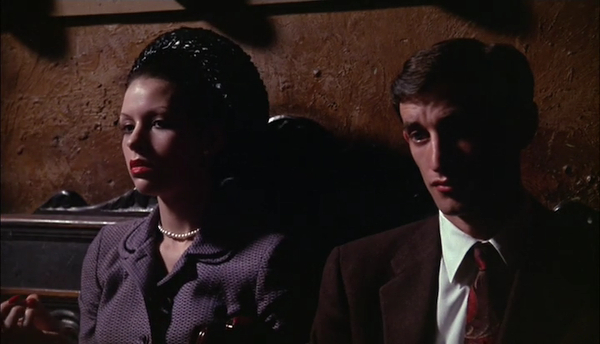
Next Stop, Greenwich Village plays as an intimate memory piece of 1953, but doesn’t have the coded, gauzy sentimentality normally attached to nostalgia. (Contemporary perceptions of past decades are shaped for many Americans through their experience of the movies. It can make people yearn for another time, without really knowing the reality of that time). Mazursky takes a tone that is less satirical (with the exception of the acting school and audition scenes and his view of pseudo-intellectuals), and the result is the most relaxed of all his films. Mazursky conjures the past – his past – with tremendous love, and devoid of irony, yet he’s frank in his depiction of the human condition in ways that reflect the social liberation of 1970s cinema. The film feels remarkably alive and present, even today.
If the film has any cinematic antecedents, it harks back to Fellini’s I Vitelloni and Amarcord. (Fellini appears as himself in Mazursky’s 1970 Alex in Wonderland, and the two directors would remain great friends up until Fellini’s death. Some of their deeply felt correspondence is reprinted in Mazursky’s book Show Me the Magic.) But where Fellini moves miles away from the realism of 1953’s I Vitelloni into complete spatial artifice with 1974’s Amarcord, showing memory as fantasia, Mazursky is firmly rooted in reality. It helps that, according to Mazursky, the Greenwich Village and Brooklyn of 1975 (when it was shot) was very similar in its architecture, side streets, bars and cafes to what was in 1953. The city feels alive and genuine. (There are significant scenes filmed in Caffe Reggio and Julius, which today remain largely unchanged.)
In many of Mazursky’s films, a conflict that would normally take an entire film’s dramatic arc to resolve becomes just another day in the life. This bohemian chamber piece unfolds as an incisive depiction of internal personal motivations and decisions, not just for Lenny, but for all the characters. Whether it’s his ambition of being an actor, to be as great as Brando, or his girlfriend Sarah’s having an abortion without guilt, it’s all equally important. (It’s her call. Larry wants to marry Sarah; she’s not interested. “Why didn’t you want to become a doctor instead of an actor? You could have performed the operation yourself.”) After the visit to the doctor – she’s given Sarah something to induce a miscarriage – Sarah, Larry and their WASP-y poet friend Robert (Christopher Walken) hop through Washington Square Park to hasten the process. (“If I bleed, she can do the abortion in the hospital. I have to do push-ups, sit-ups, jumping, anything.”) Mazursky frames the trio in a romantic wide shot enveloped by the trees, the beauty of the city and the world they live in. The power is that it’s a joyous image.
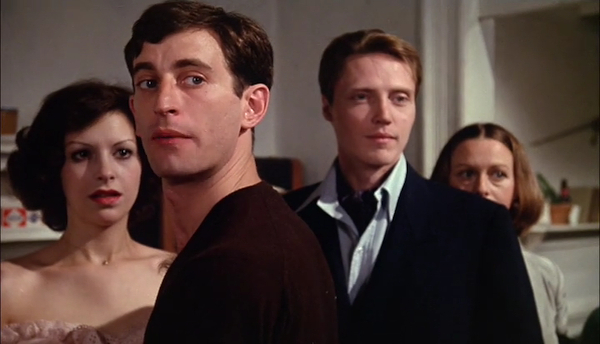
The characters inhabit and define the world, rather than illustrate it. There’s a looseness and immediacy to the dialogue and the actors interplay that feels improvisational, yet Mazursky has written it all with deceptive control. And the expressive cinematography, here by Arthur Ornitz, is freer than seen in other Mazursky films – the camera travels with characters as they move onto the streets, conveying an exuberant freedom, even if, in one instance, their group sidewalk conga line is headed to check in on a friend who may have committed suicide. The soundtrack is primarily scored to Dave Brubeck recordings, with some original score by Bill Conti played by the great Paul Desmond. The music is intricate and intimate, but, as used here, it isn’t mixed for effect; it feels part of the atmosphere, even if not emanating from a café jukebox. And though the cues lean on the classic 1959 Brubeck album Time Out, the spirit doesn’t feel anachronistic to Mazursky’s 1953 New York. (Seeing the film in 1976 may have been the first time I’d ever properly heard Brubeck and Desmond, and this entry point for me is intertwined.)
Mazursky’s films are always a treasure for actors, and here he assembled a phenomenal ensemble cast that also includes Dori Brenner, Antonio Fargas, Jeff Goldblum, Lois Smith, Helen Hanft, Lou Jacobi, and Ellen Greene in her film debut as Sarah. (“A ravishing Semitic beauty,” declares Bernstein, played by the great Fargas. “So are you, kiddo” she replies.) Physically Baker is all sharp angles, with his wiry, skinny, taut body, long limbs, quizzical eyes, hard jaw-line and prominent aquiline nose, but there’s complex shading in his performance and he uses his distinct physicality to great comic effect in his Larry the actor “on” moments, while deeply sexy in his scenes with Greene (you know they have hot sex) and tightly wound in Oedipal angst in the presence of his domineering mother. (Mazursky described Baker as “beautiful,” saying he had “a poetic Jewishness.” Alan Ladd, Jr., then the head of 20th Century Fox, the studio that financed the film, said more bluntly, “You could cut bread with his nose.”)
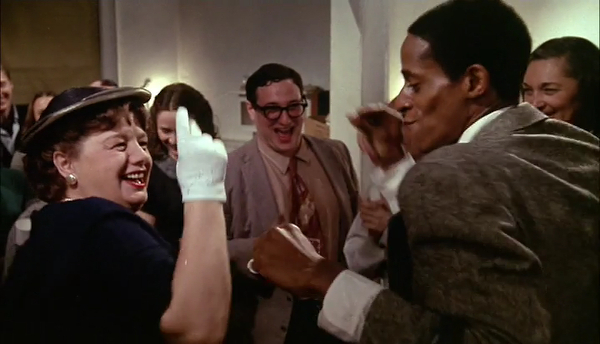
Looking like the Ma Joad of Brooklyn, Shelley Winters portrays Faye Lapinsky (based in Mazursky’s mother Jean) with remarkably complexity. When she dances to a Glenn Miller swing record with Bernstein at Larry’s rent party (she arrives uninvited), the weight of her despair and her body disappears. (“Who are you?” she asks. “I’m Bernstein.” “You’re Jewish?” “No darling, I’m gay.” “I don’t care how you feel, you’re a great dancer!”) It’s easy to see how she could be charming, and liked – even loved – by everyone. Here, in this moment, among all of Larry’s friends, in this bohemian life, she comes alive because she’s welcomed as another eccentric outsider. And in her dance, she’s a star; the life of the party.
Early in the film, there’s a touching scene in which Ben and Faye visit Larry’s sparsely furnished Village flat for the first time (“You call this an apartment?” she predictably asks). After a pot-boiled chicken dinner, they sit listening to a record of the tenor Jussi Björling singing Tosca. (Known as the Swedish Caruso, Björling was Jean Mazursky’s favorite opera singer.) The music brings Faye to tears. Here is a woman who can be moved by art, by beauty. She feels abandoned because Larry left to live in the Village and he’s the closest she has to someone who can understand the transcendence of something like Björling’s voice. (Larry can’t see this, but Mazursky, in hindsight, can.) She can’t find normal ways to connect with her son – everything comes out as aggression and oppression – but sitting there together with the music, in that moment, they’re close. (“It’s really beautiful,” Larry says in reaction to the music, without placation.) Mazursky shows such compassion for Faye here. Her weeping isn’t played for laughs.
In the ’70s, there were films that prominently depicted the Jewish mother as simplified grotesques or clichés, including Carl Reiner’s 1970 Where’s Poppa?, the ill-fated Ernest Lehman 1972 film version of Philip Roth’s Portnoy’s Complaint, and Shelley Winters (again) in Ronald Neame’s 1972 disaster classic The Poseidon Adventure. In Next Stop, Greenwich Village, Winters gives the most fully realized portrayal of this archetype ever on screen. Mazursky described his own mother as a Jewish gypsy. (My mother was much more like Sarah – beautiful, complex and sharp-witted.) Jean would wear exotic get-ups and turbans, and steal him away from school as a boy to go see Les Enfants du Paradis or head uptown to the Apollo to see Billie Holiday or Dinah Washington. Her marriage to his father was seemingly loveless. Mazursky had a painful relationship with his mother, dealt with better on film than in real life. Jean threatened to sue her son over a brief portrayal of her in Alex in Wonderland. In Sam Wasson’s book Paul on Masursky, Wasson asks the director if he could have made Next Stop while Jean (who died in 1971) was still alive. “I wouldn’t have had the courage,” Mazursky said. “I can’t imagine what she would have done if she saw Next Stop. She would have had me put away.”
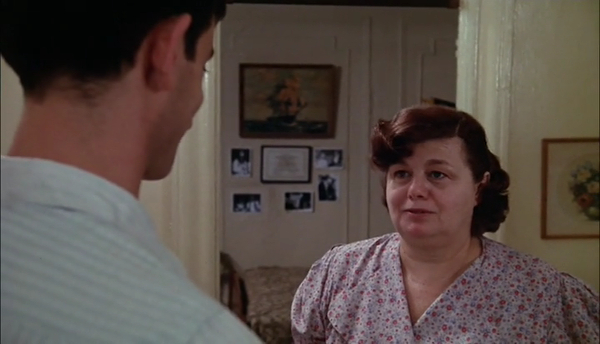
When Larry is back in Brownsville before leaving for California (he’s landed a role in a Hollywood film,) Faye says to him with yearning sincerity, “If you ever actually meet Clark Gable, tell him your mother loved him all of her life, and she saw every picture if ever did.” And then as he turns to leave, she adds, “Larry. Be a good actor.” The way Winters places the emphasis on “good” with such rooted gentleness, her read of that one word becomes the emotional climax of the film. It’s the first support she’s offered without command, and it’s easy then to understand why Larry kept that merit certificate on the wall in the first place. To be acknowledged is everything.


